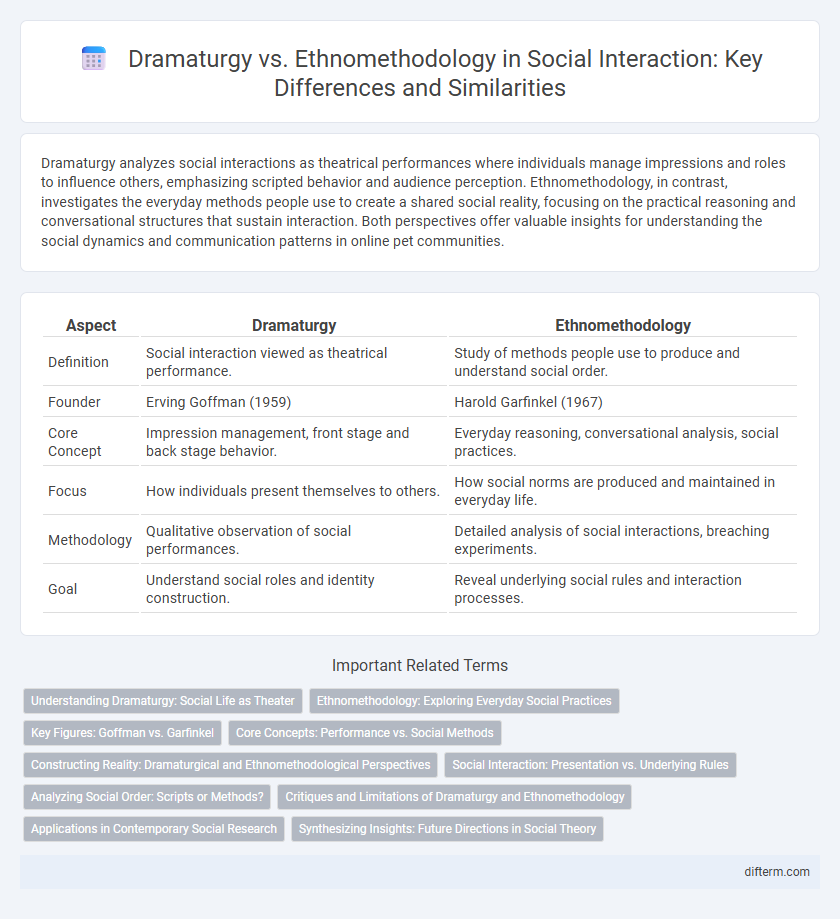Dramaturgy analyzes social interactions as theatrical performances where individuals manage impressions and roles to influence others, emphasizing scripted behavior and audience perception. Ethnomethodology, in contrast, investigates the everyday methods people use to create a shared social reality, focusing on the practical reasoning and conversational structures that sustain interaction. Both perspectives offer valuable insights for understanding the social dynamics and communication patterns in online pet communities.
Table of Comparison
| Aspect | Dramaturgy | Ethnomethodology |
|---|---|---|
| Definition | Social interaction viewed as theatrical performance. | Study of methods people use to produce and understand social order. |
| Founder | Erving Goffman (1959) | Harold Garfinkel (1967) |
| Core Concept | Impression management, front stage and back stage behavior. | Everyday reasoning, conversational analysis, social practices. |
| Focus | How individuals present themselves to others. | How social norms are produced and maintained in everyday life. |
| Methodology | Qualitative observation of social performances. | Detailed analysis of social interactions, breaching experiments. |
| Goal | Understand social roles and identity construction. | Reveal underlying social rules and interaction processes. |
Understanding Dramaturgy: Social Life as Theater
Dramaturgy presents social life as a theatrical performance where individuals manage impressions and roles to influence others' perceptions. This perspective emphasizes front-stage and back-stage behaviors, highlighting how social interactions are scripted and performed according to situational contexts. In contrast to ethnomethodology, which analyzes everyday practices and the methods people use to create social order, dramaturgy focuses on the symbolic presentation and manipulation of self in social settings.
Ethnomethodology: Exploring Everyday Social Practices
Ethnomethodology investigates the routine social practices individuals use to create and maintain a shared sense of reality, emphasizing the methods people deploy to make interactions meaningful. Unlike dramaturgy, which frames social life as theatrical performance with roles and scripts, ethnomethodology focuses on the underlying, often unnoticed, conversational and behavioral norms that structure daily interactions. Key concepts include "accounts," or the explanations people provide for their actions, and "indexicality," the context-dependent nature of meaning in social communication.
Key Figures: Goffman vs. Garfinkel
Erving Goffman, the key proponent of dramaturgy, conceptualized social interactions as theatrical performances where individuals manage their self-presentation using roles, scripts, and stages to influence others' perceptions. Harold Garfinkel, the founder of ethnomethodology, focused on the everyday methods people employ to produce and make sense of social order, emphasizing conversational analysis and background practices that sustain social reality. These approaches diverge on viewing social life either as managed performance (Goffman) or as practical reasoning processes (Garfinkel), shaping foundational understandings in microsociology.
Core Concepts: Performance vs. Social Methods
Dramaturgy emphasizes social life as a theatrical performance where individuals manage impressions and roles to influence others' perceptions. Ethnomethodology focuses on the everyday methods people use to construct and maintain social order through routine interactions. The core distinction lies in dramaturgy's analysis of performative roles versus ethnomethodology's examination of the underlying social practices enabling coherent communication.
Constructing Reality: Dramaturgical and Ethnomethodological Perspectives
Dramaturgy explores social interaction as a theatrical performance where individuals manage impressions to construct reality, emphasizing front-stage and back-stage behaviors. Ethnomethodology investigates the everyday methods people use to produce and understand social order, highlighting conversational analysis and the implicit rules guiding interactions. Both perspectives reveal how reality is actively constructed through social practices, yet dramaturgy focuses on performative self-presentation while ethnomethodology emphasizes the procedural generation of meaning.
Social Interaction: Presentation vs. Underlying Rules
Dramaturgy emphasizes the presentation of self in social interactions, highlighting how individuals perform roles to shape others' perceptions. Ethnomethodology investigates the underlying rules and tacit methods that people use to create and sustain social order in everyday interactions. Understanding both approaches reveals the contrast between visible social performances and the hidden, rule-governed processes that make interaction meaningful.
Analyzing Social Order: Scripts or Methods?
Dramaturgy analyzes social order through scripted performances and role-playing, emphasizing how individuals construct identity in social interactions. Ethnomethodology focuses on the methods people use to produce and maintain social order in everyday life, highlighting the implicit rules and practices underlying social exchanges. Both approaches reveal different layers of social organization, with dramaturgy spotlighting behavioral scripts and ethnomethodology uncovering procedural foundations.
Critiques and Limitations of Dramaturgy and Ethnomethodology
Critiques of dramaturgy highlight its overly theatrical metaphor, which can oversimplify complex social interactions by framing all behavior as performance, thus neglecting underlying structural and material influences. Ethnomethodology faces limitations due to its intense micro-level focus on everyday practices, often ignoring broader social contexts and power relations that shape these interactions. Both approaches struggle with generalizability, as dramaturgy's metaphor and ethnomethodology's detailed analysis may fail to address larger systemic patterns in society.
Applications in Contemporary Social Research
Dramaturgy analyzes social interactions as theatrical performances, emphasizing roles, scripts, and audience perceptions to understand identity construction and impression management. Ethnomethodology examines the everyday methods individuals use to produce and maintain social order, focusing on conversational analysis and practical reasoning in natural settings. Both approaches provide valuable frameworks for contemporary social research, with dramaturgy highlighting performative aspects and ethnomethodology emphasizing the micro-level processes that sustain social reality.
Synthesizing Insights: Future Directions in Social Theory
Dramaturgy explores social interaction as theatrical performance, emphasizing roles, scripts, and audience perceptions, while ethnomethodology investigates the everyday methods individuals use to construct social reality. Synthesizing these approaches enriches social theory by integrating the performative aspects of identity with the procedural understanding of social order. Future research directions include examining digital interactions and virtual identities to better understand how people negotiate social norms in increasingly mediated environments.
dramaturgy vs ethnomethodology Infographic

 difterm.com
difterm.com